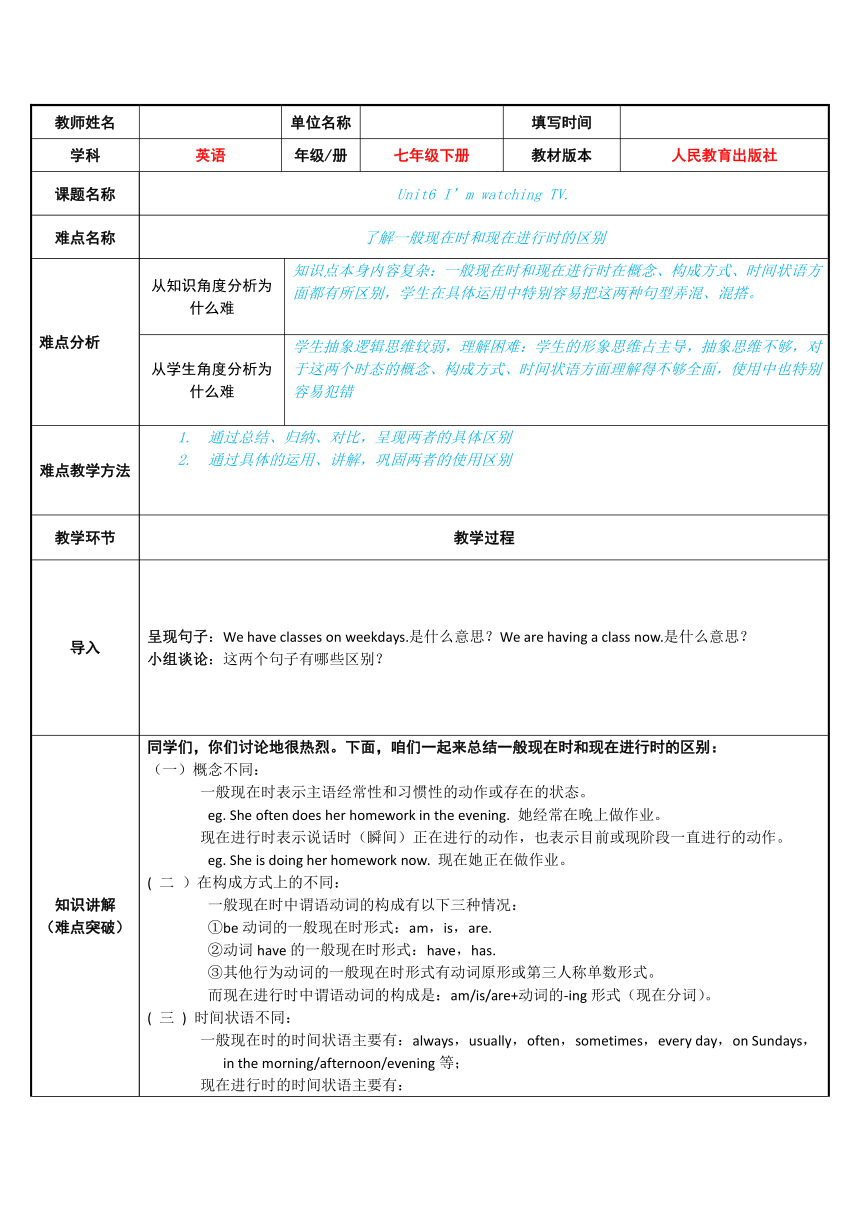Unit 6 I'm watching TV-了解一般现在时和现在进行时的区别教案
文档属性
| 名称 | Unit 6 I'm watching TV-了解一般现在时和现在进行时的区别教案 |  | |
| 格式 | docx | ||
| 文件大小 | 16.7KB | ||
| 资源类型 | 教案 | ||
| 版本资源 | 人教新目标(Go for it)版 | ||
| 科目 | 英语 | ||
| 更新时间 | 2022-04-18 22:03:08 | ||
图片预览

文档简介
教师姓名 单位名称 填写时间
学科 英语 年级/册 七年级下册 教材版本 人民教育出版社
课题名称 Unit6 I’m watching TV.
难点名称 了解一般现在时和现在进行时的区别
难点分析 从知识角度分析为什么难 知识点本身内容复杂:一般现在时和现在进行时在概念、构成方式、时间状语方面都有所区别,学生在具体运用中特别容易把这两种句型弄混、混搭。
从学生角度分析为什么难 学生抽象逻辑思维较弱,理解困难:学生的形象思维占主导,抽象思维不够,对于这两个时态的概念、构成方式、时间状语方面理解得不够全面,使用中也特别容易犯错
难点教学方法 通过总结、归纳、对比,呈现两者的具体区别 通过具体的运用、讲解,巩固两者的使用区别
教学环节 教学过程
导入 呈现句子:We have classes on weekdays.是什么意思?We are having a class now.是什么意思? 小组谈论:这两个句子有哪些区别?
知识讲解 (难点突破) 同学们,你们讨论地很热烈。下面,咱们一起来总结一般现在时和现在进行时的区别: (一)概念不同: 一般现在时表示主语经常性和习惯性的动作或存在的状态。 eg. She often does her homework in the evening. 她经常在晚上做作业。 现在进行时表示说话时(瞬间)正在进行的动作,也表示目前或现阶段一直进行的动作。 eg. She is doing her homework now. 现在她正在做作业。 ( 二 )在构成方式上的不同: 一般现在时中谓语动词的构成有以下三种情况: ①be动词的一般现在时形式:am,is,are. ②动词have的一般现在时形式:have,has. ③其他行为动词的一般现在时形式有动词原形或第三人称单数形式。 而现在进行时中谓语动词的构成是:am/is/are+动词的-ing形式(现在分词)。 ( 三 ) 时间状语不同: 一般现在时的时间状语主要有:always,usually,often,sometimes,every day,on Sundays, in the morning/afternoon/evening等; 现在进行时的时间状语主要有: now,these days,this week,at the moment等,有时句首有“Look!”、“Listen!”或者 “It’s+时刻”等词、句存在。如: eg. We play football in the afternoon.我们在下午踢足球。(一般现在时) My mother is reading a newspaper now. 我妈妈正在看报纸。(现在进行时)
课堂练习 (难点巩固) 同学们,下面我们来做些相应的练习。完成之后,我们一起来核对答案: (一)用所给动词的适当形式填空.() 1. He ___ (like) watching TV. But now he_________ (not watch) TV. He ________ (read) a book. 2. Look! The children ____________ (swim) in the river. 3. We _______(clean) our classroom every day. 4. --- Does Jim ____(run) every day ---Yes,he_____. ---____he______(run)now ---No, he ____. He ________( play) football. 5. We ____ (do) our homework every day. Now we ________ (do) our homework in the classroom. 6. Sometimes Li Ping ____ (have) lunch at home. But now he ________(have) lunch at school. 7.Sometimes they _____ (watch) TV after school. But now they ____________ (not watch) TV. They ________ (play) games. 8.My sister _____(read) English every morning. But now she _______ (read) Chinese. 9. He likes _______ (help) people. 10.When ___ you ___(go) to work every morning ( 二 ) 时态转换练习: 1. She does the shopping on Sundays. She ____ _____ the shopping now. 2. We play basketball every day. We _____ _______ basketball now. 3. He has some oranges at 7:00. He ____ _____ some oranges now. 4. They don’t wash their clothes every day. They ______ ______ their clothes now. 5. Does Ann speak Chinese __ __ Ann _______ Chinese with them now 答案:(一)用所给动词的适当形式填空:1.likes, isn’t watching, is reading 2. are swimming 3. clean 4.run, does, Is, running, isn’t, is playing 5. do, are doing 6. has, is having 7. watch, aren’t watching, are playing 8. reads, is reading 9. helping 10. do, go (二) 时态转换练习: 1.is doing 2. are playing 3. is having 4. aren’t washing 5. Is speaking
小结 同学们,这节课,我们学习了一般现在时和现在进行时在概念、构成方式、时间状语方面的区别。希望你们能全面掌握,并能正确运用。
学科 英语 年级/册 七年级下册 教材版本 人民教育出版社
课题名称 Unit6 I’m watching TV.
难点名称 了解一般现在时和现在进行时的区别
难点分析 从知识角度分析为什么难 知识点本身内容复杂:一般现在时和现在进行时在概念、构成方式、时间状语方面都有所区别,学生在具体运用中特别容易把这两种句型弄混、混搭。
从学生角度分析为什么难 学生抽象逻辑思维较弱,理解困难:学生的形象思维占主导,抽象思维不够,对于这两个时态的概念、构成方式、时间状语方面理解得不够全面,使用中也特别容易犯错
难点教学方法 通过总结、归纳、对比,呈现两者的具体区别 通过具体的运用、讲解,巩固两者的使用区别
教学环节 教学过程
导入 呈现句子:We have classes on weekdays.是什么意思?We are having a class now.是什么意思? 小组谈论:这两个句子有哪些区别?
知识讲解 (难点突破) 同学们,你们讨论地很热烈。下面,咱们一起来总结一般现在时和现在进行时的区别: (一)概念不同: 一般现在时表示主语经常性和习惯性的动作或存在的状态。 eg. She often does her homework in the evening. 她经常在晚上做作业。 现在进行时表示说话时(瞬间)正在进行的动作,也表示目前或现阶段一直进行的动作。 eg. She is doing her homework now. 现在她正在做作业。 ( 二 )在构成方式上的不同: 一般现在时中谓语动词的构成有以下三种情况: ①be动词的一般现在时形式:am,is,are. ②动词have的一般现在时形式:have,has. ③其他行为动词的一般现在时形式有动词原形或第三人称单数形式。 而现在进行时中谓语动词的构成是:am/is/are+动词的-ing形式(现在分词)。 ( 三 ) 时间状语不同: 一般现在时的时间状语主要有:always,usually,often,sometimes,every day,on Sundays, in the morning/afternoon/evening等; 现在进行时的时间状语主要有: now,these days,this week,at the moment等,有时句首有“Look!”、“Listen!”或者 “It’s+时刻”等词、句存在。如: eg. We play football in the afternoon.我们在下午踢足球。(一般现在时) My mother is reading a newspaper now. 我妈妈正在看报纸。(现在进行时)
课堂练习 (难点巩固) 同学们,下面我们来做些相应的练习。完成之后,我们一起来核对答案: (一)用所给动词的适当形式填空.() 1. He ___ (like) watching TV. But now he_________ (not watch) TV. He ________ (read) a book. 2. Look! The children ____________ (swim) in the river. 3. We _______(clean) our classroom every day. 4. --- Does Jim ____(run) every day ---Yes,he_____. ---____he______(run)now ---No, he ____. He ________( play) football. 5. We ____ (do) our homework every day. Now we ________ (do) our homework in the classroom. 6. Sometimes Li Ping ____ (have) lunch at home. But now he ________(have) lunch at school. 7.Sometimes they _____ (watch) TV after school. But now they ____________ (not watch) TV. They ________ (play) games. 8.My sister _____(read) English every morning. But now she _______ (read) Chinese. 9. He likes _______ (help) people. 10.When ___ you ___(go) to work every morning ( 二 ) 时态转换练习: 1. She does the shopping on Sundays. She ____ _____ the shopping now. 2. We play basketball every day. We _____ _______ basketball now. 3. He has some oranges at 7:00. He ____ _____ some oranges now. 4. They don’t wash their clothes every day. They ______ ______ their clothes now. 5. Does Ann speak Chinese __ __ Ann _______ Chinese with them now 答案:(一)用所给动词的适当形式填空:1.likes, isn’t watching, is reading 2. are swimming 3. clean 4.run, does, Is, running, isn’t, is playing 5. do, are doing 6. has, is having 7. watch, aren’t watching, are playing 8. reads, is reading 9. helping 10. do, go (二) 时态转换练习: 1.is doing 2. are playing 3. is having 4. aren’t washing 5. Is speaking
小结 同学们,这节课,我们学习了一般现在时和现在进行时在概念、构成方式、时间状语方面的区别。希望你们能全面掌握,并能正确运用。
同课章节目录
- Unit 1 Can you play the guitar?
- Section A
- Section B
- Unit 2 What time do you go to school?
- Section A
- Section B
- Unit 3 How do you get to school?
- Section A
- Section B
- Unit 4 Don't eat in class.
- Section A
- Section B
- Unit 5 Why do you like pandas?
- Section A
- Section B
- Unit 6 I'm watching TV.
- Section A
- Section B
- Review of Units 1-6
- Unit 7 It's raining!
- Section A
- Section B
- Unit 8 Is there a post office near here?
- Section A
- Section B
- Unit 9 What does he look like?
- Section A
- Section B
- Unit 10 I'd like some noodles.
- Section A
- Section B
- Unit 11 How was your school trip?
- Section A
- Section B
- Unit 12 What did you do last weekend?
- Section A
- Section B
